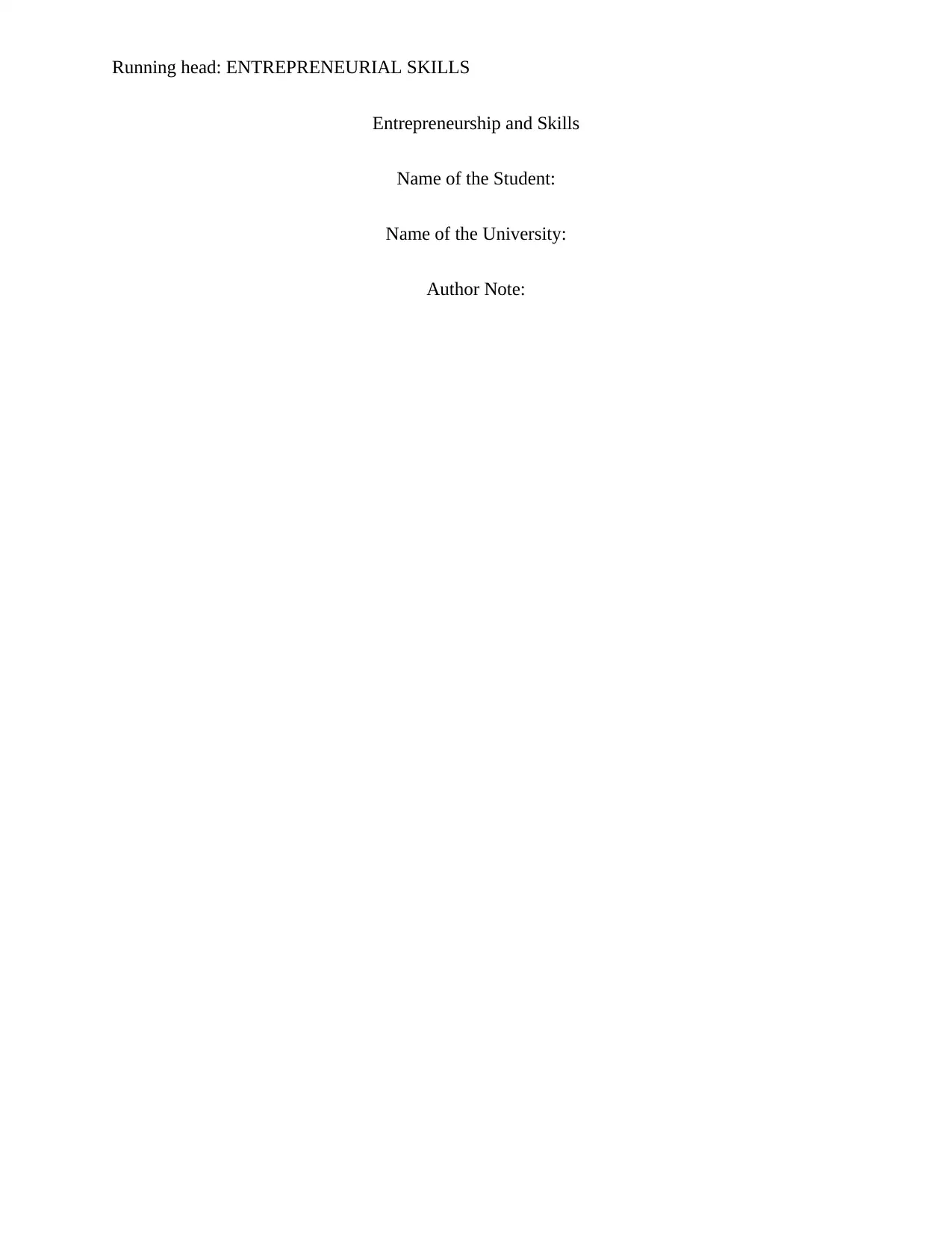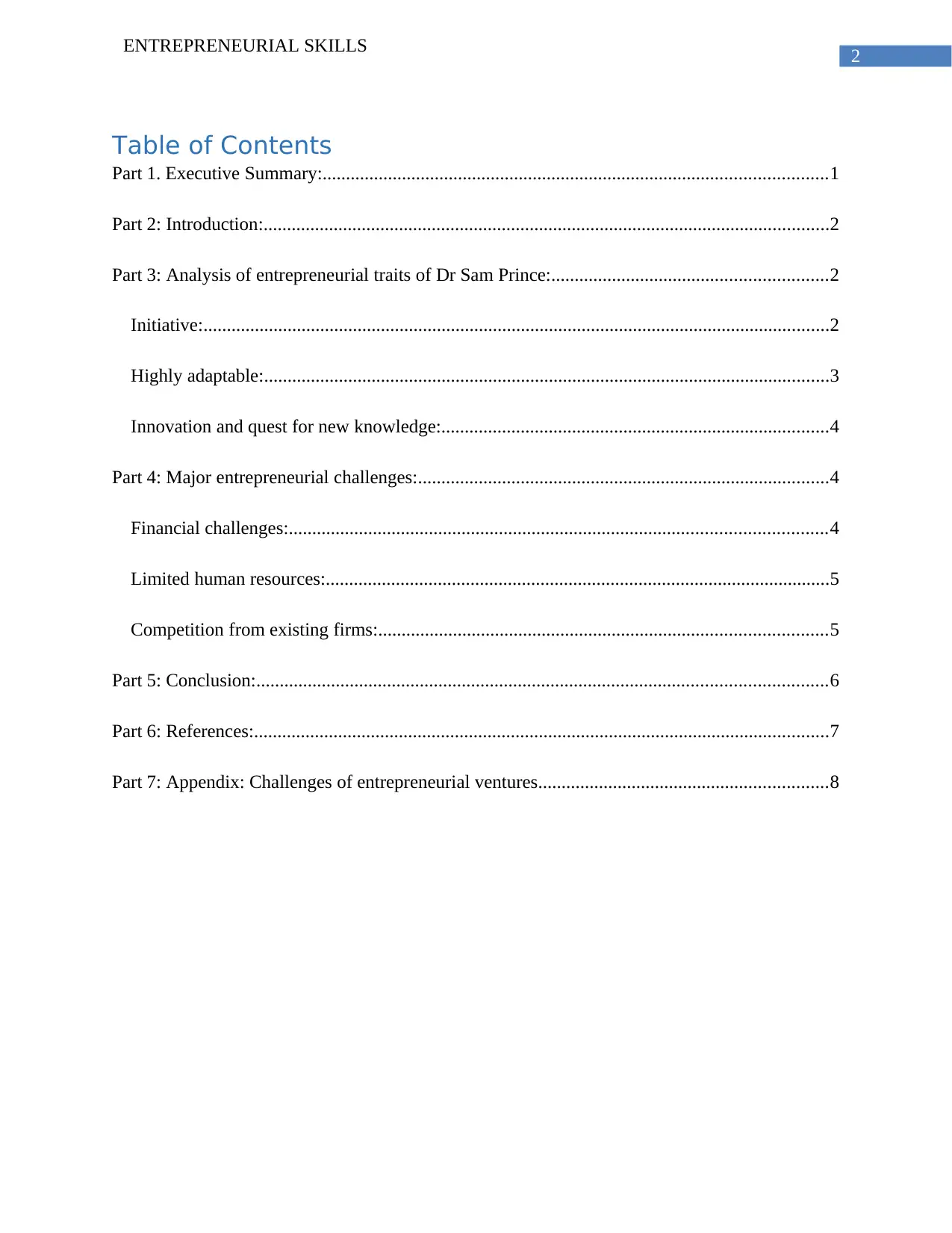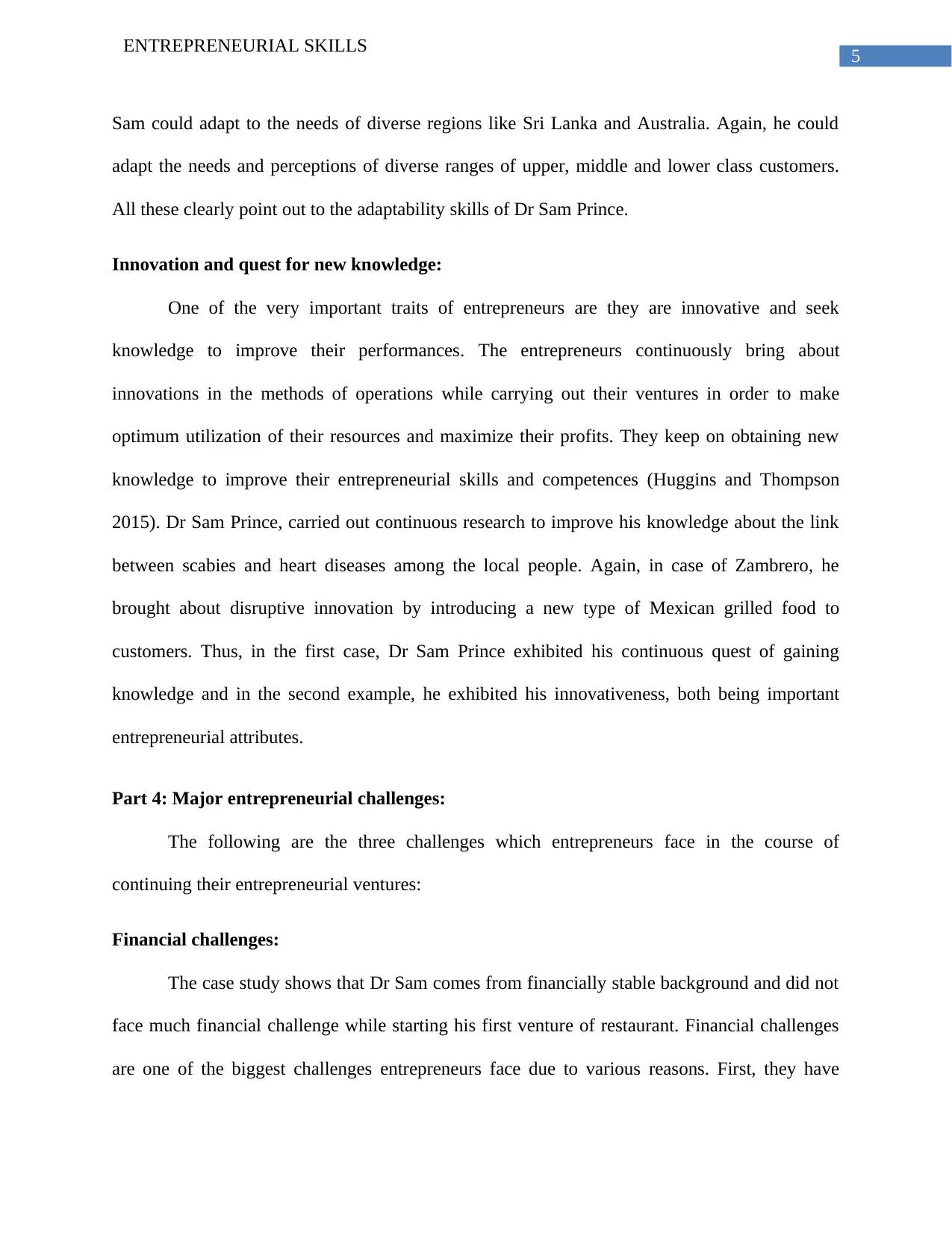Entrepreneurial Skills: Analysis of Dr. Sam Prince's Ventures Report
VerifiedAdded on 2021/04/21
|10
|1847
|359
Report
AI Summary
This report provides an in-depth analysis of entrepreneurial skills and challenges, using Dr. Sam Prince as a case study. It begins with an executive summary and introduction to entrepreneurship, defining the concept and highlighting key attributes like initiative, adaptability, and innovation. The report then analyzes Dr. Prince's entrepreneurial traits, referencing his ventures such as Zambrero and One Disease at a Time, to illustrate these qualities. Furthermore, it explores major entrepreneurial challenges, including financial constraints, limited human resources, and competition from established firms. The report concludes by summarizing the key findings and emphasizing the importance of risk-taking and innovation in entrepreneurial ventures. The document also includes a references section and an appendix outlining challenges of entrepreneurial ventures.

Running head: ENTREPRENEURIAL SKILLS
Entrepreneurship and Skills
Name of the Student:
Name of the University:
Author Note:
Entrepreneurship and Skills
Name of the Student:
Name of the University:
Author Note:
Paraphrase This Document
Need a fresh take? Get an instant paraphrase of this document with our AI Paraphraser

1
ENTREPRENEURIAL SKILLS
Part 1. Executive Summary:
The aim of the paper is to study entrepreneurial attributes and skills. The study is based on the
story of Dr Sam Prince, a doctor and entrepreneur by profession. The first section delves into
entrepreneurial attributes taking Dr Prince as the example while the second section delves into
entrepreneurial challenges.
ENTREPRENEURIAL SKILLS
Part 1. Executive Summary:
The aim of the paper is to study entrepreneurial attributes and skills. The study is based on the
story of Dr Sam Prince, a doctor and entrepreneur by profession. The first section delves into
entrepreneurial attributes taking Dr Prince as the example while the second section delves into
entrepreneurial challenges.

2
ENTREPRENEURIAL SKILLS
Table of Contents
Part 1. Executive Summary:............................................................................................................1
Part 2: Introduction:.........................................................................................................................2
Part 3: Analysis of entrepreneurial traits of Dr Sam Prince:...........................................................2
Initiative:......................................................................................................................................2
Highly adaptable:.........................................................................................................................3
Innovation and quest for new knowledge:...................................................................................4
Part 4: Major entrepreneurial challenges:........................................................................................4
Financial challenges:...................................................................................................................4
Limited human resources:............................................................................................................5
Competition from existing firms:................................................................................................5
Part 5: Conclusion:..........................................................................................................................6
Part 6: References:...........................................................................................................................7
Part 7: Appendix: Challenges of entrepreneurial ventures..............................................................8
ENTREPRENEURIAL SKILLS
Table of Contents
Part 1. Executive Summary:............................................................................................................1
Part 2: Introduction:.........................................................................................................................2
Part 3: Analysis of entrepreneurial traits of Dr Sam Prince:...........................................................2
Initiative:......................................................................................................................................2
Highly adaptable:.........................................................................................................................3
Innovation and quest for new knowledge:...................................................................................4
Part 4: Major entrepreneurial challenges:........................................................................................4
Financial challenges:...................................................................................................................4
Limited human resources:............................................................................................................5
Competition from existing firms:................................................................................................5
Part 5: Conclusion:..........................................................................................................................6
Part 6: References:...........................................................................................................................7
Part 7: Appendix: Challenges of entrepreneurial ventures..............................................................8
⊘ This is a preview!⊘
Do you want full access?
Subscribe today to unlock all pages.

Trusted by 1+ million students worldwide

3
ENTREPRENEURIAL SKILLS
Part 2: Introduction:
Entrepreneurship refers to the procedure of initiating new business ventures to derive
profits by taking the risks associated with them. The entrepreneurs invest in new business
ventures, take the risks to bring about new products. They introduce new products in the market
and create new employment opportunities. The entrepreneurs are attributed with certain traits or
qualities which help them to drive their entrepreneurial ventures like innovative, initiative nature
and adaptability to situations. These attributes would be studied through Dr Sam Prince, the
social entrepreneur in the given case study around which the paper revolves. The report would
analyses these qualities by taking examples from different entrepreneurial aspects of Sam Prince.
Them it would go on to study the challenges entrepreneurs face while carrying on their business
ventures. The three impediments pointed out in the paper are lack of financial resources, lack of
human resources and lack of competitive advantages against the established companies.
Part 3: Analysis of entrepreneurial traits of Dr Sam Prince:
The following are the traits entrepreneurs like Dr Sam Prince are expected to have:
Initiative:
The first trait entrepreneurs are expected to have is initiative and will to start new
business ventures. Entrepreneurs recognize new needs in the market which have to fulfill which
they use as opportunities to start new business ventures. The entrepreneurs take initiatives to
amass resources to start the business ventures like acquiring financial resources, human
resources and material resources (Drucker 2014). Sam Prince was a doctor who ran multiple
business ventures like holding a chain of restaurant called Zambrero in Australia and founder of
a nonprofit organization called One Disease at a time. He was a doctor by profession and
ENTREPRENEURIAL SKILLS
Part 2: Introduction:
Entrepreneurship refers to the procedure of initiating new business ventures to derive
profits by taking the risks associated with them. The entrepreneurs invest in new business
ventures, take the risks to bring about new products. They introduce new products in the market
and create new employment opportunities. The entrepreneurs are attributed with certain traits or
qualities which help them to drive their entrepreneurial ventures like innovative, initiative nature
and adaptability to situations. These attributes would be studied through Dr Sam Prince, the
social entrepreneur in the given case study around which the paper revolves. The report would
analyses these qualities by taking examples from different entrepreneurial aspects of Sam Prince.
Them it would go on to study the challenges entrepreneurs face while carrying on their business
ventures. The three impediments pointed out in the paper are lack of financial resources, lack of
human resources and lack of competitive advantages against the established companies.
Part 3: Analysis of entrepreneurial traits of Dr Sam Prince:
The following are the traits entrepreneurs like Dr Sam Prince are expected to have:
Initiative:
The first trait entrepreneurs are expected to have is initiative and will to start new
business ventures. Entrepreneurs recognize new needs in the market which have to fulfill which
they use as opportunities to start new business ventures. The entrepreneurs take initiatives to
amass resources to start the business ventures like acquiring financial resources, human
resources and material resources (Drucker 2014). Sam Prince was a doctor who ran multiple
business ventures like holding a chain of restaurant called Zambrero in Australia and founder of
a nonprofit organization called One Disease at a time. He was a doctor by profession and
Paraphrase This Document
Need a fresh take? Get an instant paraphrase of this document with our AI Paraphraser

4
ENTREPRENEURIAL SKILLS
continued his medical practices. This analysis shows that Dr Prince had the quality to take
initiative in starting ventures to fulfill the different needs of the market. Zambrero was opened by
by Sam to offer healthy Mexican food while the NGO One Disease at a Time worked towards
eradication of scabies among the local communities of Australia. Sam, a doctor treated patients
and helped them recover them from diseases. This shows that Sam had the entrepreneurial
attribute of taking initiatives to start ventures to meet the growing needs in the society (Dees
2017).
Highly adaptable:
The next trait which entrepreneurs are expected to have is adaptability to different market
situations. The entrepreneurs have the quality to recognize the market opportunities and
capitalize them to start business ventures. They have the power to foresee market challenges and
adapt to them to sustain (Burns 2016). The case study clearly mentions that Sam hails from Sri
Lanka, has the citizenship of Australia and was born in Scotland. This means that he had the
capability to adapt to the social conditions in these diverse cultures. Sam as an entrepreneurs ran
a restaurant which offered Mexican food and ran a non-profit making organization called One
Disease at a time which treated the local population of Australia suffering from scabies. An
analysis of these two diverse ventures would clearly point out to Dr Sam’s adaptability to the
needs of different customer segment. Zambrero was a multinational restaurant chain serving
Mexican food which must have been expensive. Here the customer segment which Dr Sam
served consisted of upper and middle strata of the society who sought healthy food items. Again,
the doctor in the non-profit organization served local people suffering from scabies. One can
point out that the average economic capacity among the indigenous population in Australia is
low and that they cannot afford expensive hospital treatments. This analysis clearly shows that
ENTREPRENEURIAL SKILLS
continued his medical practices. This analysis shows that Dr Prince had the quality to take
initiative in starting ventures to fulfill the different needs of the market. Zambrero was opened by
by Sam to offer healthy Mexican food while the NGO One Disease at a Time worked towards
eradication of scabies among the local communities of Australia. Sam, a doctor treated patients
and helped them recover them from diseases. This shows that Sam had the entrepreneurial
attribute of taking initiatives to start ventures to meet the growing needs in the society (Dees
2017).
Highly adaptable:
The next trait which entrepreneurs are expected to have is adaptability to different market
situations. The entrepreneurs have the quality to recognize the market opportunities and
capitalize them to start business ventures. They have the power to foresee market challenges and
adapt to them to sustain (Burns 2016). The case study clearly mentions that Sam hails from Sri
Lanka, has the citizenship of Australia and was born in Scotland. This means that he had the
capability to adapt to the social conditions in these diverse cultures. Sam as an entrepreneurs ran
a restaurant which offered Mexican food and ran a non-profit making organization called One
Disease at a time which treated the local population of Australia suffering from scabies. An
analysis of these two diverse ventures would clearly point out to Dr Sam’s adaptability to the
needs of different customer segment. Zambrero was a multinational restaurant chain serving
Mexican food which must have been expensive. Here the customer segment which Dr Sam
served consisted of upper and middle strata of the society who sought healthy food items. Again,
the doctor in the non-profit organization served local people suffering from scabies. One can
point out that the average economic capacity among the indigenous population in Australia is
low and that they cannot afford expensive hospital treatments. This analysis clearly shows that

5
ENTREPRENEURIAL SKILLS
Sam could adapt to the needs of diverse regions like Sri Lanka and Australia. Again, he could
adapt the needs and perceptions of diverse ranges of upper, middle and lower class customers.
All these clearly point out to the adaptability skills of Dr Sam Prince.
Innovation and quest for new knowledge:
One of the very important traits of entrepreneurs are they are innovative and seek
knowledge to improve their performances. The entrepreneurs continuously bring about
innovations in the methods of operations while carrying out their ventures in order to make
optimum utilization of their resources and maximize their profits. They keep on obtaining new
knowledge to improve their entrepreneurial skills and competences (Huggins and Thompson
2015). Dr Sam Prince, carried out continuous research to improve his knowledge about the link
between scabies and heart diseases among the local people. Again, in case of Zambrero, he
brought about disruptive innovation by introducing a new type of Mexican grilled food to
customers. Thus, in the first case, Dr Sam Prince exhibited his continuous quest of gaining
knowledge and in the second example, he exhibited his innovativeness, both being important
entrepreneurial attributes.
Part 4: Major entrepreneurial challenges:
The following are the three challenges which entrepreneurs face in the course of
continuing their entrepreneurial ventures:
Financial challenges:
The case study shows that Dr Sam comes from financially stable background and did not
face much financial challenge while starting his first venture of restaurant. Financial challenges
are one of the biggest challenges entrepreneurs face due to various reasons. First, they have
ENTREPRENEURIAL SKILLS
Sam could adapt to the needs of diverse regions like Sri Lanka and Australia. Again, he could
adapt the needs and perceptions of diverse ranges of upper, middle and lower class customers.
All these clearly point out to the adaptability skills of Dr Sam Prince.
Innovation and quest for new knowledge:
One of the very important traits of entrepreneurs are they are innovative and seek
knowledge to improve their performances. The entrepreneurs continuously bring about
innovations in the methods of operations while carrying out their ventures in order to make
optimum utilization of their resources and maximize their profits. They keep on obtaining new
knowledge to improve their entrepreneurial skills and competences (Huggins and Thompson
2015). Dr Sam Prince, carried out continuous research to improve his knowledge about the link
between scabies and heart diseases among the local people. Again, in case of Zambrero, he
brought about disruptive innovation by introducing a new type of Mexican grilled food to
customers. Thus, in the first case, Dr Sam Prince exhibited his continuous quest of gaining
knowledge and in the second example, he exhibited his innovativeness, both being important
entrepreneurial attributes.
Part 4: Major entrepreneurial challenges:
The following are the three challenges which entrepreneurs face in the course of
continuing their entrepreneurial ventures:
Financial challenges:
The case study shows that Dr Sam comes from financially stable background and did not
face much financial challenge while starting his first venture of restaurant. Financial challenges
are one of the biggest challenges entrepreneurs face due to various reasons. First, they have
⊘ This is a preview!⊘
Do you want full access?
Subscribe today to unlock all pages.

Trusted by 1+ million students worldwide

6
ENTREPRENEURIAL SKILLS
limited financial resources to start entrepreneurial ventures and get very limited financial help
from banks due to lack of financial backing. Secondly, they have to compete against the
established firms in the market to earn profits and sustain. These financial challenges often
impedes entrepreneurial ventures and even result in their collapse (Piperopoulos 2016).
Limited human resources:
The entrepreneurs face the challenge of acquiring talented human resources due to their
limited financial strength and power to pay the employee high salary. The case study shows Dr
Sam when he has already gained success and hence, is also a sought after employer. However,
entrepreneurs have to face the challenge of acquiring highly skilled employees. This prevents
them from carrying out their entrepreneurial operations and strategies successfully which
ultimately tantamount to inefficient business operations (Miller, Xu and Mehrotra 2015).
Competition from existing firms:
New entrepreneurial ventures have to face strong challenges from the established firms in
the market. These established firms already have their loyal customers and pose threats to the
revenue generation of the new firms. Moreover, the established firms already have their own
supply chains which provide them with high quality raw materials at economic rates. These firms
also have skilled human resources which account for their efficient operations. Thus, established
firms are able to reduce their cost of production and increase their profit margin (Brinckmann
and Kim 2015). The new entrepreneurial ventures as discussed above have limited financial
resources which impedes them from acquiring high quality raw materials at economic rates. This
means they have to acquire raw materials at high prices which increases their cost of production.
Again, lack of availability of skilled human resources impedes their efficiency of operations.
These factors limits their competitive power in the market to compete against the established
ENTREPRENEURIAL SKILLS
limited financial resources to start entrepreneurial ventures and get very limited financial help
from banks due to lack of financial backing. Secondly, they have to compete against the
established firms in the market to earn profits and sustain. These financial challenges often
impedes entrepreneurial ventures and even result in their collapse (Piperopoulos 2016).
Limited human resources:
The entrepreneurs face the challenge of acquiring talented human resources due to their
limited financial strength and power to pay the employee high salary. The case study shows Dr
Sam when he has already gained success and hence, is also a sought after employer. However,
entrepreneurs have to face the challenge of acquiring highly skilled employees. This prevents
them from carrying out their entrepreneurial operations and strategies successfully which
ultimately tantamount to inefficient business operations (Miller, Xu and Mehrotra 2015).
Competition from existing firms:
New entrepreneurial ventures have to face strong challenges from the established firms in
the market. These established firms already have their loyal customers and pose threats to the
revenue generation of the new firms. Moreover, the established firms already have their own
supply chains which provide them with high quality raw materials at economic rates. These firms
also have skilled human resources which account for their efficient operations. Thus, established
firms are able to reduce their cost of production and increase their profit margin (Brinckmann
and Kim 2015). The new entrepreneurial ventures as discussed above have limited financial
resources which impedes them from acquiring high quality raw materials at economic rates. This
means they have to acquire raw materials at high prices which increases their cost of production.
Again, lack of availability of skilled human resources impedes their efficiency of operations.
These factors limits their competitive power in the market to compete against the established
Paraphrase This Document
Need a fresh take? Get an instant paraphrase of this document with our AI Paraphraser

7
ENTREPRENEURIAL SKILLS
firms and generate revenue. This results in their poor economic performances and consequent
closure (Rees and Smith 2017) (Appendix).
Part 5: Conclusion:
The above study shows that entrepreneurs have certain traits like initiative power which
encourage them to start business ventures. They have the capability of accumulating financial,
material and human resources to run business ventures. However, they also have to face several
impediments which prevents them from operating smoothly. Their lack of financial resources
prevents them from acquiring efficient human resources, thus jeopardizing their business
efficiency. However, the risk taking nature of entrepreneurs encourage them to take up these
challenges to pursue with their business ventures to establish them in the market. They also strive
to bring about innovation and maximize wealth.
ENTREPRENEURIAL SKILLS
firms and generate revenue. This results in their poor economic performances and consequent
closure (Rees and Smith 2017) (Appendix).
Part 5: Conclusion:
The above study shows that entrepreneurs have certain traits like initiative power which
encourage them to start business ventures. They have the capability of accumulating financial,
material and human resources to run business ventures. However, they also have to face several
impediments which prevents them from operating smoothly. Their lack of financial resources
prevents them from acquiring efficient human resources, thus jeopardizing their business
efficiency. However, the risk taking nature of entrepreneurs encourage them to take up these
challenges to pursue with their business ventures to establish them in the market. They also strive
to bring about innovation and maximize wealth.

8
ENTREPRENEURIAL SKILLS
Part 6: References:
Brinckmann, J. and Kim, S.M., 2015. Why we plan: the impact of nascent entrepreneurs'
cognitive characteristics and human capital on business planning. Strategic entrepreneurship
journal, 9(2), pp.153-166.
Burns, P., 2016. Entrepreneurship and small business. Palgrave Macmillan Limited.
Dees, J.G., 2017. 1 The Meaning of Social Entrepreneurship. In Case Studies in Social
Entrepreneurship and Sustainability(pp. 34-42). Routledge.
Drucker, P., 2014. Innovation and entrepreneurship. Routledge.
Eesley, C. and Miller, W., 2017. Impact: Stanford University's Economic Impact via Innovation
and Entrepreneurship.
Huggins, R. and Thompson, P., 2015. Entrepreneurship, innovation and regional growth: a
network theory. Small Business Economics, 45(1), pp.103-128.
Khajeheian, D., 2016. Audience commodification: A source of innovation in business
models. Technology Innovation Management Review, 6(8).
Miller, D., Xu, X. and Mehrotra, V., 2015. When is human capital a valuable resource? The
performance effects of Ivy League selection among celebrated CEOs. Strategic Management
Journal, 36(6), pp.930-944.
Piperopoulos, P.G., 2016. Entrepreneurship, innovation and business clusters. Routledge.
Rees, G. and Smith, P. eds., 2017. Strategic human resource management: An international
perspective. Sage.
ENTREPRENEURIAL SKILLS
Part 6: References:
Brinckmann, J. and Kim, S.M., 2015. Why we plan: the impact of nascent entrepreneurs'
cognitive characteristics and human capital on business planning. Strategic entrepreneurship
journal, 9(2), pp.153-166.
Burns, P., 2016. Entrepreneurship and small business. Palgrave Macmillan Limited.
Dees, J.G., 2017. 1 The Meaning of Social Entrepreneurship. In Case Studies in Social
Entrepreneurship and Sustainability(pp. 34-42). Routledge.
Drucker, P., 2014. Innovation and entrepreneurship. Routledge.
Eesley, C. and Miller, W., 2017. Impact: Stanford University's Economic Impact via Innovation
and Entrepreneurship.
Huggins, R. and Thompson, P., 2015. Entrepreneurship, innovation and regional growth: a
network theory. Small Business Economics, 45(1), pp.103-128.
Khajeheian, D., 2016. Audience commodification: A source of innovation in business
models. Technology Innovation Management Review, 6(8).
Miller, D., Xu, X. and Mehrotra, V., 2015. When is human capital a valuable resource? The
performance effects of Ivy League selection among celebrated CEOs. Strategic Management
Journal, 36(6), pp.930-944.
Piperopoulos, P.G., 2016. Entrepreneurship, innovation and business clusters. Routledge.
Rees, G. and Smith, P. eds., 2017. Strategic human resource management: An international
perspective. Sage.
⊘ This is a preview!⊘
Do you want full access?
Subscribe today to unlock all pages.

Trusted by 1+ million students worldwide

9
ENTREPRENEURIAL SKILLS
Part 7: Appendix: Challenges of entrepreneurial ventures
Entrepreneurial
ventures
Limited
financial
resources
Limited
human
resources
and material
resources
Poor
business
outcomes
and profits
Low
competitive
advanatge
ENTREPRENEURIAL SKILLS
Part 7: Appendix: Challenges of entrepreneurial ventures
Entrepreneurial
ventures
Limited
financial
resources
Limited
human
resources
and material
resources
Poor
business
outcomes
and profits
Low
competitive
advanatge
1 out of 10
Related Documents
Your All-in-One AI-Powered Toolkit for Academic Success.
+13062052269
info@desklib.com
Available 24*7 on WhatsApp / Email
![[object Object]](/_next/static/media/star-bottom.7253800d.svg)
Unlock your academic potential
Copyright © 2020–2025 A2Z Services. All Rights Reserved. Developed and managed by ZUCOL.




